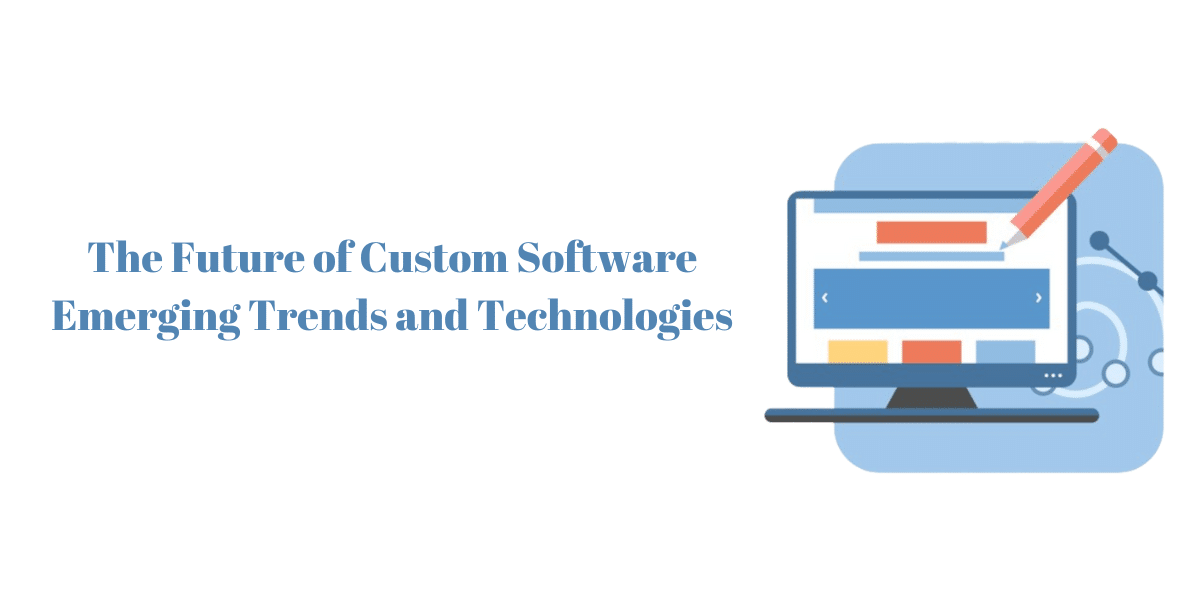In the ever-evolving landscape of technology, the future of custom software development stands at the forefront of innovation, propelled by emerging trends and cutting-edge technologies. As businesses worldwide increasingly recognize the pivotal role of tailored custom software solutions, a dynamic shift is underway, shaping the landscape of how software is conceived, developed, and deployed. This journey into the future encompasses a fusion of artificial intelligence, blockchain integration, and cloud-native development, promising unparalleled efficiency and functionality.
The integration of 5G technology, augmented reality, and the Internet of Things further amplifies the transformative potential of custom software. This introduction explores the intricate web of emerging trends, from the intricacies of microservices architecture to the ethical considerations steering the course of custom software development. As we delve into the complexities and possibilities that lie ahead, this exploration aims to illuminate the path forward, offering insights into the multifaceted future of custom software and the technologies that will shape its destiny.
Rise of Artificial Intelligence in Custom Software
The ascent of Artificial Intelligence (AI) marks a pivotal epoch in the realm of custom software development, heralding a transformative era of unprecedented capabilities and efficiency. AI’s integration into custom software solutions has become a cornerstone, offering intelligent automation, data analysis, and cognitive computing to revolutionize how applications are designed and executed. Machine learning algorithms, a subset of AI, empower software to adapt and learn from patterns, enhancing predictive capabilities and enabling tailored user experiences.
One notable facet of AI’s rise in custom software lies in its ability to streamline decision-making processes. AI-driven systems can analyze vast datasets with remarkable speed, providing valuable insights that guide strategic choices and optimize performance. Moreover, the infusion of AI into custom software contributes to enhanced personalization, as algorithms can discern user preferences and behaviors, tailoring interfaces and functionalities to individual needs.
As custom software evolves, natural language processing (NLP) and computer vision, integral components of AI, emerge as game-changers. NLP facilitates seamless interactions between users and software through voice commands or text, while computer vision empowers applications to interpret and respond to visual data. This convergence of AI technologies not only augments the sophistication of custom software but also opens avenues for innovative applications across diverse industries.
In essence, the rise of AI in custom software epitomizes a paradigm shift, where intelligent algorithms, learning mechanisms, and advanced analytics converge to redefine the boundaries of what software can achieve. As this symbiotic relationship unfolds, the synergy between human ingenuity and machine intelligence promises a future where custom software is not merely functional but serves as a dynamic, intelligent ally in the pursuit of innovation and efficiency.
Blockchain Integration in Custom Software Solutions
The integration of blockchain technology into custom software solutions represents a revolutionary stride toward fostering transparency, security, and decentralization. Blockchain, originally designed as the underlying infrastructure for cryptocurrencies like Bitcoin, has evolved into a robust framework with applications extending far beyond the realm of finance. In the context of custom software, its integration brings about a paradigm shift in data management, transactional integrity, and trust mechanisms.
At its core, blockchain operates as a decentralized, distributed ledger that records transactions across a network of computers in a secure and immutable manner. This fundamental characteristic addresses longstanding challenges in custom software related to data security and trust. Through cryptographic hashing and consensus algorithms, blockchain ensures that once data is recorded, it cannot be altered retroactively, thereby fortifying the integrity of information stored within custom software applications.
Smart contracts, self-executing contracts with the terms of the agreement directly written into code, exemplify a potent application of blockchain in custom software. These programmable contracts automate and enforce the execution of predefined rules, eliminating the need for intermediaries and reducing the risk of fraud. Such automation streamlines processes, reduces costs, and enhances efficiency in various industries.
Moreover, blockchain’s decentralized nature mitigates the risk of a single point of failure, enhancing the robustness of custom software solutions. Whether in supply chain management, healthcare, or identity verification, the integration of blockchain technology brings forth a new era where custom software not only performs its designated functions but also fosters a secure, transparent, and resilient digital environment.
Cloud-Native Development for Custom Software
Cloud-native development emerges as a transformative paradigm in the landscape of custom software, offering a dynamic approach that leverages the power of cloud computing to enhance scalability, agility, and efficiency. At its essence, cloud-native development is centered around building and deploying applications that fully capitalize on cloud infrastructure, services, and principles. This departure from traditional monolithic architectures towards microservices-based structures enables custom software to evolve and adapt swiftly in response to changing requirements and user demands.
One of the fundamental advantages of cloud-native development is its scalability. By breaking down applications into smaller, modular components or microservices, custom software gains the ability to scale specific functionalities independently. This not only optimizes resource utilization but also allows for seamless adaptation to fluctuating workloads, enhancing overall performance and user experience.
Furthermore, cloud-native development emphasizes containerization, where applications and their dependencies are packaged in isolated units known as containers. This approach ensures consistency across various environments, streamlining the development-to-deployment pipeline and fostering collaboration among development and operations teams.
The integration of continuous delivery and deployment practices within cloud-native development accelerates the software development life cycle. Automation tools facilitate the testing, integration, and deployment of code changes, promoting a more efficient and reliable development process. This iterative and automated approach aligns seamlessly with the principles of agility, enabling custom software to evolve rapidly and stay abreast of emerging trends and user expectations.
In conclusion, cloud-native development stands as a cornerstone in the evolution of development custom software solutions, ushering in an era of heightened adaptability, scalability, and efficiency. By harnessing the capabilities of cloud computing, this approach not only reshapes the development landscape but also ensures that custom software is well-positioned to meet the challenges of a dynamic and ever-evolving digital environment.
Progressive Web Applications (PWAs) in the Future of Custom Software
Progressive Web Applications (PWAs) emerge as a pivotal force shaping the future of custom software, offering a hybrid approach that combines the best features of web and native applications. These applications leverage web technologies to deliver an immersive, fast, and reliable user experience, blurring the lines between traditional websites and native mobile apps. In the evolving landscape of custom software, PWAs represent a paradigm shift, providing enhanced accessibility and functionality while minimizing the complexities associated with traditional development approaches.
One of the defining features of PWAs is their responsiveness across a myriad of devices and screen sizes. This responsiveness, coupled with offline capabilities enabled by service workers, ensures a seamless user experience even in low or no connectivity scenarios. As the digital ecosystem becomes increasingly diverse, PWAs stand out for their ability to cater to users across various platforms, whether accessed from a desktop browser or a mobile device.
PWAs also embrace the principles of discoverability and accessibility. Unlike native apps that require installation, PWAs are accessible through web URLs, eliminating the need for app store downloads. This not only simplifies the user onboarding process but also enhances discoverability, making custom software more readily available to a broader audience.
Moreover, PWAs are designed to be progressively enhanced, allowing developers to implement features that align with the capabilities of the user’s device. This approach ensures a consistent and optimal user experience while also accommodating diverse technological landscapes.
In summary, Progressive Web Applications represent a forward-looking approach in the future of custom software, offering a harmonious blend of accessibility, responsiveness, and user-centric design. As the digital realm continues to evolve, PWAs stand as a testament to the adaptability and innovation inherent in the ongoing evolution of custom software development.
Impact of 5G on Custom Software Development
The advent of 5G technology is poised to revolutionize custom software development, ushering in an era of unprecedented connectivity, speed, and transformative possibilities. The impact of 5G on custom software development is multifaceted, promising to reshape the way applications are designed, deployed, and experienced by users. At its core, 5G represents a significant leap forward in terms of network speed and bandwidth, providing developers with the foundation to create more robust and data-intensive applications.
One of the primary effects of 5G on custom software lies in enhanced speed and low-latency communication. The significantly reduced latency, often in the range of milliseconds, ensures that data is transmitted swiftly between devices and servers. This not only results in faster load times for applications but also opens the door for the development of real-time, immersive experiences such as augmented reality (AR) and virtual reality (VR) applications.
The increased bandwidth offered by 5G facilitates the seamless integration of data-heavy features, high-quality multimedia content, and complex functionalities within custom software. Developers can leverage this expanded capacity to create applications that harness the full potential of emerging technologies, pushing the boundaries of what was previously achievable.
Furthermore, 5G’s impact extends to the Internet of Things (IoT), enabling a more interconnected and responsive network for IoT devices. Custom software designed for IoT applications can now leverage 5G’s capabilities to efficiently process and transmit data, fostering a more efficient and dynamic ecosystem of connected devices.
In conclusion, the advent of 5G technology marks a pivotal moment in custom software development, empowering developers to craft applications that harness the full potential of high-speed, low-latency communication. As 5G continues to proliferate globally, the impact on custom software is poised to be transformative, unlocking new dimensions of innovation and user experiences.
Augmented Reality (AR) and Virtual Reality (VR) in Custom Software
The integration of Augmented Reality (AR) and Virtual Reality (VR) into custom software heralds a paradigm shift, expanding the horizons of user interaction and creating immersive digital experiences. AR overlays digital information onto the real world, enhancing the user’s perception, while VR immerses users in entirely virtual environments. The fusion of AR and VR with custom software opens up new possibilities across diverse industries, transforming how applications are designed, experienced, and leveraged.
In custom software development solutions, AR’s real-time integration with the user’s environment facilitates interactive and context-aware experiences. Applications can overlay digital information, graphics, or 3D models onto the physical world, creating innovative solutions for fields such as education, healthcare, and retail. For instance, AR-powered custom software can offer interactive training simulations, visualize medical data during surgeries, or enable virtual try-on experiences for retail consumers.
Conversely, VR in custom software takes users to entirely simulated environments, offering a fully immersive experience. Industries ranging from gaming and education to architecture and healthcare can leverage VR to provide realistic simulations, virtual training environments, or architectural walkthroughs. Custom software designed for VR enhances user engagement and understanding by transporting individuals to environments where they can interact with information in three-dimensional space.
The synergy of AR and VR with custom software is not only limited to entertainment but extends to practical, business-oriented applications. From virtual meetings and collaborative workspaces to product prototyping and design visualization, the incorporation of AR and VR technologies enriches the custom software landscape, unlocking a new dimension of user experiences and pushing the boundaries of what is achievable in the digital realm.
Internet of Things (IoT) and Custom Software Synergy
The synergy between the Internet of Things (IoT) and custom software represents a transformative alliance, reshaping how devices communicate, share data, and operate within interconnected ecosystems. IoT, characterized by the interconnectivity of physical devices through the internet, finds its true potential unlocked through the development of tailored custom software. This collaboration not only facilitates efficient communication between devices but also empowers businesses and industries across various sectors by providing real-time insights, automation, and enhanced control.
Custom software tailored for IoT environments plays a pivotal role in aggregating, analyzing, and interpreting the vast volumes of data generated by interconnected devices. It enables organizations to derive meaningful insights, monitor performance, and make data-driven decisions. Whether in smart homes, industrial settings, or healthcare applications, the symbiosis of IoT and custom software creates intelligent ecosystems capable of adapting to dynamic conditions and user requirements.
Moreover, custom software in the IoT landscape facilitates seamless integration and interoperability among diverse devices. It ensures that data from sensors, actuators, and other IoT components can be efficiently processed and utilized to drive coordinated actions. This integration is particularly crucial in industrial settings, where IoT-enabled custom software can optimize processes, monitor equipment health, and enhance overall operational efficiency.
The security and scalability of IoT ecosystems are also enhanced through bespoke custom software solutions. Security protocols, data encryption, and user authentication mechanisms can be intricately woven into the software architecture, addressing concerns related to privacy and data integrity. Additionally, custom software allows for scalability, accommodating the addition of new devices and functionalities as IoT networks expand and evolve.
In essence, the synergy between IoT and custom software catalyzes a technological revolution, fostering innovation and efficiency across industries. As IoT continues to proliferate, the role of custom software in harnessing its potential becomes increasingly indispensable, paving the way for a connected, intelligent future.
Edge Computing and Its Role in Custom Software Trends
Edge computing stands as a pivotal force in shaping custom software trends, introducing a decentralized paradigm that redistributes computing resources closer to the data source rather than relying solely on centralized cloud servers. This transformative approach addresses the challenges posed by latency, bandwidth constraints, and the need for real-time data processing, marking a significant evolution in how custom software applications are architected and deployed.
At its core, edge computing involves processing data locally on devices or in close proximity to the source of data generation. This shift from traditional cloud-centric models offers several advantages in custom software development. By reducing the distance between data processing and the point of use, edge computing minimizes latency, ensuring faster response times critical for applications requiring real-time interactions, such as IoT devices, augmented reality, and autonomous systems.
Custom software designed with edge computing in mind gains the ability to operate more efficiently in resource-constrained environments. Edge devices, ranging from sensors to edge servers, can execute certain computing tasks locally, alleviating the burden on central cloud infrastructure. This decentralized approach enhances scalability and resilience, particularly in scenarios where continuous connectivity to the cloud may be unreliable or impractical.
Furthermore, edge computing is instrumental in addressing privacy and security concerns. By processing sensitive data locally, custom software can minimize the exposure of critical information to external networks, reducing the risk of data breaches and ensuring compliance with privacy regulations.
In conclusion, the integration of edge computing into custom software trends heralds a new era of responsiveness, efficiency, and security. As the digital landscape continues to evolve, edge computing emerges as a cornerstone in enabling applications to meet the demands of real-time processing, fostering innovation across diverse industries.
Quantum Computing’s Potential Impact on Custom Software
Quantum computing, with its unparalleled ability to process complex calculations at speeds unimaginable by classical computers, holds the potential to revolutionize the landscape of custom software development. As quantum computers harness the principles of quantum mechanics to manipulate quantum bits or qubits, custom software faces the prospect of addressing problems that were once deemed insurmountable, paving the way for transformative advancements in various domains.
One of the most profound impacts of quantum computing on custom software lies in its ability to solve complex problems exponentially faster than classical computers. Algorithms specifically designed for quantum computing, such as Shor’s algorithm for factorization and Grover’s algorithm for search, promise to revolutionize cryptography, optimization, and data analysis. Custom software tailored to leverage these quantum algorithms could unlock new possibilities in areas like secure communications, supply chain optimization, and advanced data analytics.
However, integrating quantum computing into custom software development poses unique challenges. Quantum computers operate under different principles than classical computers, requiring a paradigm shift in software architecture and algorithm design. Quantum software development, often referred to as quantum programming, demands expertise in quantum mechanics and a novel approach to problem-solving.
Moreover, the impact of quantum computing extends beyond solving specific problems faster; it may usher in entirely new computational paradigms. Quantum machine learning, quantum cryptography, and quantum simulations represent areas where custom software could harness the power of quantum computing to address challenges that were previously deemed intractable.
In essence, quantum computing’s potential impact on custom software is profound, offering the prospect of tackling complex problems and unlocking unprecedented computational capabilities. As quantum technologies continue to advance, custom software developers must navigate this uncharted territory, exploring innovative solutions that harness the transformative potential of quantum computing.
Cybersecurity Innovations for Future Custom Software
In the ever-evolving landscape of custom software development, the future is intricately tied to cybersecurity innovations that aim to fortify digital ecosystems against emerging threats. As technology advances, so do the complexities and sophistication of cyber threats, necessitating continuous evolution in cybersecurity measures. Future custom software development is poised to integrate innovative solutions that address vulnerabilities, protect sensitive data, and ensure the resilience of applications against ever-evolving cyber risks.
One notable cybersecurity innovation for future custom software lies in the adoption of advanced authentication methods. Beyond traditional passwords, custom software is expected to leverage multifactor authentication, biometrics, and behavioral analytics to enhance user identity verification. These measures not only bolster the security of sensitive information but also offer a more user-friendly and adaptive authentication experience.
Machine learning and artificial intelligence are integral components of future cybersecurity innovations in custom software. These technologies enable predictive threat analysis, anomaly detection, and adaptive security protocols. Custom software equipped with AI-driven cybersecurity mechanisms can autonomously identify and respond to emerging threats in real-time, significantly enhancing the overall resilience of applications against evolving attack vectors.
The integration of decentralized identity and blockchain technology represents another frontier in future custom software cybersecurity. Blockchain’s immutable and transparent nature enhances data integrity, while decentralized identity frameworks provide users with greater control over their personal information. Custom software leveraging these innovations can create a more secure and privacy-centric digital environment, particularly crucial in applications dealing with sensitive data and user credentials.
In conclusion, the future of custom software development is intricately linked to cybersecurity innovations that proactively address the challenges posed by a dynamic threat landscape. By incorporating advanced authentication, AI-driven threat detection, and decentralized identity solutions, custom software developers are poised to create digital ecosystems that not only meet today’s security standards but also anticipate and mitigate the cybersecurity challenges of tomorrow.
Low-Code and No-Code Platforms in Custom Software Development
The advent of low-code and no-code platforms is reshaping the landscape of custom software development, ushering in an era of rapid application development and democratizing the creation of software solutions. These platforms empower individuals with varying levels of technical expertise to contribute to the development process, reducing the reliance on traditional coding and expediting the time from ideation to deployment.
Low-code platforms offer a visual development environment with pre-built components and drag-and-drop functionality, enabling developers to streamline the creation of custom software applications. These platforms often feature automation tools, making it easier to design workflows, integrate with external systems, and implement business logic without extensive coding efforts. No-code platforms take this abstraction a step further, allowing individuals with minimal technical background to create functional applications through intuitive interfaces and predefined templates.
The adoption of low-code and no-code platforms in custom software development brings several advantages. Firstly, it accelerates the development life cycle, allowing for faster prototyping and iteration. This increased speed is particularly beneficial in environments where quick adaptation to changing requirements is essential. Secondly, these platforms enhance collaboration between technical and non-technical stakeholders, fostering a more inclusive and cross-functional development process. Thirdly, low-code and no-code solutions facilitate a more agile approach, enabling organizations to respond swiftly to market demands and user feedback.
While low-code and no-code platforms offer substantial benefits in terms of speed and accessibility, developers must balance these advantages with considerations related to scalability, customization, and the complexity of applications. Nevertheless, the growing prominence of these platforms signals a paradigm shift in custom software development, emphasizing efficiency, collaboration, and accessibility for a broader spectrum of individuals involved in the software creation process.
DevOps Practices Shaping the Future of Custom Software
DevOps practices are proving to be a transformative force in shaping the future of custom software development, fostering a collaborative and iterative approach that bridges the gap between software development and IT operations. DevOps, derived from the combination of “Development” and “Operations,” advocates for a culture of collaboration, automation, and continuous integration to deliver software faster, more reliably, and with increased efficiency.
One key aspect of DevOps influencing the future of custom software is the emphasis on continuous integration and continuous delivery (CI/CD). These practices streamline the development pipeline, enabling developers to integrate code changes frequently and automating the testing and deployment processes. This iterative approach ensures that software is delivered more rapidly, with a focus on minimizing errors and enhancing overall reliability.
Automation is a cornerstone of DevOps practices, and its role in custom software development is becoming increasingly significant. Automation tools for configuration management, testing, and deployment contribute to a more efficient and consistent development process. This not only accelerates the delivery of custom software but also reduces the likelihood of human errors in manual processes.
DevOps practices also promote a shift-left mentality, encouraging collaboration between development and operations teams from the early stages of software development. This approach enhances communication, reduces silos, and ensures that operational considerations are integrated into the development process. As a result, custom software is not only functionally robust but also aligns seamlessly with operational requirements and considerations.
In conclusion, DevOps practices are reshaping the future of custom software solutions by instilling a culture of collaboration, automation, and continuous improvement. As organizations increasingly adopt DevOps principles, the development and deployment of custom software will become more efficient, reliable, and responsive to the evolving needs of users and the business.
Microservices Architecture and Custom Software Scalability
Microservices architecture has emerged as a foundational approach in custom software development, particularly in addressing the critical aspect of scalability. This architectural style involves breaking down a software application into a set of small, independent services that communicate through well-defined APIs. The scalability benefits of microservices architecture are manifold, offering a flexible and efficient solution to accommodate varying workloads and evolving business requirements.
Scalability in microservices architecture is inherent due to the independent nature of each service. Custom software designed with microservices can scale specific components independently based on demand, allowing for a more targeted and efficient allocation of resources. This modular approach facilitates the deployment of additional instances of high-demand services without affecting the entire application, providing a responsive solution to varying levels of user traffic and ensuring optimal performance.
Moreover, microservices promote a decentralized and distributed system, reducing bottlenecks and enhancing the overall resilience of custom software. Each microservice operates independently, enabling organizations to scale individual services horizontally as needed. This not only improves the system’s ability to handle increased loads but also enhances fault isolation, ensuring that the failure of one service does not cascade across the entire application.
Additionally, microservices architecture aligns well with modern custom software development practices, enabling agile development, faster releases, and improved maintainability. Teams can independently develop, deploy, and scale individual microservices, facilitating parallel development efforts and minimizing dependencies.
In conclusion, the adoption of microservices architecture plays a pivotal role in addressing custom software scalability challenges. By providing a modular, independent, and decentralized structure, microservices empower organizations to build scalable and resilient software systems that can evolve in tandem with changing demands and business dynamics.
Human-Centric Design in Future Custom Software
The future of custom software is increasingly shaped by the principles of human-centric design, emphasizing user experience, accessibility, and empathy in the development process. Human-centric design goes beyond functional requirements, placing the needs, preferences, and behaviors of end-users at the forefront of software development. This approach is poised to redefine how custom software is conceived, ensuring that applications are not only technologically advanced but also intuitive, user-friendly, and aligned with the diverse needs of the users they serve.
In the realm of future custom software, the focus on human-centric design extends to personalized user experiences. Tailoring software interfaces and functionalities to individual user preferences enhances engagement and satisfaction. Machine learning algorithms, coupled with user feedback and behavior analysis, enable custom software to adapt and evolve, creating a more intuitive and personalized user journey.
Accessibility is another cornerstone of human-centric design in the future of custom software. As technology becomes more pervasive, ensuring that software is accessible to users with diverse abilities and needs is paramount. Future custom software is expected to integrate features like voice interfaces, screen readers, and other assistive technologies to enhance usability for individuals with varying levels of physical or cognitive abilities.
Moreover, human-centric design promotes a collaborative approach, involving end-users in the design and testing phases of software development. This participatory engagement ensures that the software aligns with user expectations, preferences, and real-world usage scenarios, ultimately leading to more effective and user-friendly solutions.
In summary, the future of custom software development is marked by a paradigm shift towards human-centric design. By prioritizing user experience, personalization, and accessibility, custom software developers are poised to create applications that not only meet functional requirements but also resonate with the diverse and evolving needs of their human users.
Personalized User Experiences in Custom Software
Personalized user experiences stand as a cornerstone in the evolution of custom software, reflecting a paradigm shift towards tailoring applications to individual preferences, behaviors, and needs. In the contemporary digital landscape, users increasingly expect software to offer more than just functionality; they seek intuitive, personalized interactions that resonate with their unique requirements. Custom software designed with a focus on personalized user experiences strives to create a dynamic and responsive environment, enhancing user satisfaction and engagement.
The integration of personalization in custom software extends beyond mere interface adjustments; it encompasses the entire user journey. Machine learning algorithms play a pivotal role, analyzing user data, behaviors, and interactions to dynamically adapt and customize the software experience. From recommending content based on user preferences to dynamically adjusting interface layouts, personalized user experiences anticipate and respond to individual needs, fostering a sense of connection and relevance.
Custom software developers leverage data-driven insights to create user profiles that guide the personalization process. These profiles consider factors such as user demographics, past interactions, and real-time behavior, allowing the software to deliver content, features, and recommendations that align with the user’s preferences and context. Whether in e-commerce, social media, or productivity applications, the integration of personalized user experiences elevates software from a mere tool to a tailored, user-centric solution.
Furthermore, personalized user experiences contribute to increased user retention and loyalty. When users feel that the software understands and caters to their unique needs, they are more likely to engage with the application regularly and advocate for its value. In essence, the future of custom software lies in its ability to not only fulfill functional requirements but also to forge meaningful, personalized connections with each user, enriching the overall digital experience.
Cross-Platform Development for Custom Software Applications
Cross-platform development has become a pivotal strategy in custom software applications, addressing the increasing diversity of devices, operating systems, and user preferences in the digital landscape. This approach involves creating software that can seamlessly run on multiple platforms, such as Windows, macOS, Linux, iOS, and Android, without requiring separate development efforts for each. The significance of cross-platform development lies in its ability to streamline the development process, enhance cost-effectiveness, and reach a broader user base.
Custom software applications designed for cross-platform compatibility leverage frameworks like Xamarin, React Native, or Flutter, which allow developers to write code once and deploy it across multiple platforms. This approach eliminates the need for separate codebases for each platform, reducing development time and resource requirements. The shared codebase ensures consistency in functionality and design, providing a unified experience for users regardless of the device or operating system they use.
The adoption of cross-platform development is particularly advantageous for businesses seeking to maximize their reach and minimize development costs. Instead of investing in separate development teams for each platform, organizations can leverage a single team skilled in cross-platform frameworks, streamlining development workflows and accelerating time-to-market. This is especially relevant in the dynamic landscape of mobile applications, where catering to both iOS and Android users is crucial for market penetration.
Moreover, cross-platform development facilitates easier maintenance and updates. Custom software developers can implement changes or add new features to the shared codebase, ensuring that updates are simultaneously deployed across all supported platforms. This results in a more efficient development lifecycle, reducing the challenges associated with managing multiple codebases and ensuring a consistent user experience across diverse devices and operating systems. In essence, the adoption of cross-platform development is a strategic move that aligns with the demand for versatile, cost-effective, and user-friendly custom software applications in today’s interconnected digital ecosystem.
Predictive Analytics in Custom Software Decision-Making
Predictive analytics stands as a powerful tool shaping the landscape of custom software development, particularly in the realm of decision-making. This innovative approach involves leveraging data, statistical algorithms, and machine learning techniques to identify patterns and make predictions about future outcomes. In custom software, the integration of predictive analytics provides a data-driven foundation for decision-makers, enabling them to anticipate trends, optimize processes, and make informed choices with greater precision.
Custom software applications incorporating predictive analytics empower organizations to extract actionable insights from vast datasets. By analyzing historical and real-time data, these applications can forecast future trends, customer behaviors, and potential outcomes. This foresight is instrumental in strategic decision-making, allowing businesses to proactively address challenges, identify opportunities, and optimize their operations.
One notable application of predictive analytics in custom software is in predictive maintenance for equipment and machinery. By analyzing historical performance data, software applications can predict when equipment is likely to fail, enabling organizations to schedule maintenance proactively, minimize downtime, and reduce maintenance costs.
Moreover, predictive analytics enhances the personalization of user experiences within custom software. By analyzing user behaviors and preferences, applications can anticipate individual needs, recommend relevant content, and tailor interfaces to optimize user engagement. This level of personalization not only enhances user satisfaction but also contributes to the overall success and adoption of the custom software.
In conclusion, predictive analytics in custom software decision-making is a transformative force, offering organizations the ability to make strategic, data-driven decisions. By leveraging advanced analytics and machine learning techniques, custom software applications can provide a competitive advantage, enabling businesses to navigate complexity, mitigate risks, and capitalize on opportunities in an increasingly dynamic and data-rich environment.
Automation and Robotics in Custom Software Workflows
The integration of automation and robotics into custom software workflows represents a revolutionary evolution in how organizations manage and optimize their business processes. Automation, the use of technology to perform tasks without human intervention, and robotics, the use of physical machines to automate tasks, combine to streamline workflows, enhance efficiency, and reduce manual effort. In custom software development, this integration offers a transformative impact on various aspects of the development life cycle.
Automation in custom software workflows ranges from code generation and testing to deployment and monitoring. Through continuous integration and continuous delivery (CI/CD) pipelines, automation tools enable developers to automate the building, testing, and deployment of code changes, ensuring a rapid and reliable software release process. Automated testing frameworks further enhance software quality, allowing for comprehensive and repeatable testing without the need for extensive manual intervention.
Robotics, when applied to custom software workflows, extends beyond the physical realm into robotic process automation (RPA). RPA involves the use of software robots to automate repetitive, rule-based tasks within software applications. These virtual robots interact with user interfaces, manipulate data, and execute predefined tasks, freeing up human resources for more complex and creative aspects of software development.
The synergy of automation and robotics in custom software workflows enhances not only the speed but also the accuracy and consistency of development processes. This integration minimizes the risk of human errors, accelerates time-to-market, and allows development teams to focus on strategic and value-added activities. As custom software workflows continue to evolve, the fusion of automation and robotics remains instrumental in driving efficiency, reducing costs, and ensuring the delivery of high-quality software solutions.
Explainable AI for Transparency in Custom Software
Explainable AI (XAI) emerges as a crucial element in custom software development, providing transparency and comprehensibility to the decision-making processes of artificial intelligence systems. As AI algorithms become increasingly complex and sophisticated, there is a growing need to demystify their decision logic, especially in applications where the impact of AI decisions has significant consequences. Explainable AI aims to make the decision-making process of AI models understandable, interpretable, and accountable to users, developers, and stakeholders.
In custom software, the integration of Explainable AI addresses the challenge of the “black box” nature often associated with complex machine learning models. By providing insights into how AI models arrive at specific conclusions, developers and end-users gain a deeper understanding of the factors influencing decisions. This transparency is particularly crucial in applications such as finance, healthcare, and criminal justice, where the rationale behind AI-driven decisions holds substantial importance.
Explainable AI not only fosters trust in AI systems but also facilitates debugging, validation, and improvement of custom software applications. Developers can identify and rectify biases, errors, or unexpected behaviors by analyzing the transparent decision pathways of AI models. This iterative process enhances the overall reliability and effectiveness of custom software.
Moreover, the transparency offered by Explainable AI aligns with regulatory requirements and ethical considerations surrounding AI applications. As regulations on data privacy and AI ethics evolve, the ability to explain and justify AI decisions becomes essential for compliance and responsible deployment of custom software.
In summary, Explainable AI is integral to ensuring transparency and accountability in custom software applications leveraging artificial intelligence. By shedding light on the decision-making processes of AI models, Explainable AI enhances trust, facilitates debugging, and aligns with ethical considerations, ultimately contributing to the responsible and effective deployment of AI in custom software development.
Sustainable and Eco-Friendly Custom Software Practices
The incorporation of sustainable and eco-friendly practices in custom software development is gaining prominence as organizations recognize the environmental impact of digital technologies. Sustainable custom software practices encompass a range of strategies aimed at minimizing the carbon footprint, optimizing resource use, and fostering a greener approach to software development. One key aspect is the efficient use of hardware resources through virtualization and cloud computing. By consolidating servers and leveraging cloud infrastructure, organizations can reduce energy consumption, minimize hardware waste, and optimize computing resources, contributing to a more sustainable custom software ecosystem.
Another essential element of eco-friendly custom software practice involves optimizing code efficiency and reducing energy-intensive computations. Streamlining algorithms and optimizing code contribute to lower energy consumption during software execution, aligning with the principles of sustainability. Additionally, adopting agile development methodologies with a focus on iterative releases and feedback loops enables quicker response to changes, reducing unnecessary development efforts and minimizing the environmental impact associated with prolonged development cycles.
The sustainable disposal and recycling of electronic waste (e-waste) resulting from outdated hardware and software components are integral to eco-friendly custom software practices. Organizations can implement recycling programs, refurbish equipment, or donate outdated technology to minimize the environmental impact of e-waste generated through the software development lifecycle.
Moreover, custom software can be designed to promote energy efficiency in end-user devices. Implementing power-saving features, optimizing data transmission, and encouraging eco-friendly user behaviors contribute to a more sustainable and energy-conscious software ecosystem.
In conclusion, the adoption of sustainable and eco-friendly practices in custom software development is essential for mitigating the environmental impact of the digital industry. By prioritizing resource efficiency, code optimization, and responsible e-waste management, organizations can contribute to a more sustainable future for custom software development.
Voice and Natural Language Processing in Custom Software
The integration of voice and natural language processing (NLP) technologies in custom software represents a transformative leap in user interactions, enabling more intuitive and conversational experiences. Voice-enabled custom software, powered by NLP, allows users to interact with applications using spoken language, fundamentally altering how users engage with technology. This innovation is particularly evident in virtual assistants, customer service chatbots, and other applications where natural and seamless communication is paramount.
Voice and NLP technologies in custom software streamline user interactions by interpreting and responding to spoken language commands. This fosters a more natural and user-friendly experience, reducing the reliance on traditional input methods such as typing or clicking. Custom software leveraging these technologies can understand context, intent, and nuances in language, enabling more sophisticated and context-aware responses.
In addition to enhanced user experience, voice and NLP in custom software contribute to accessibility and inclusivity. Users with varying levels of literacy or physical abilities can benefit from voice-driven interfaces, broadening the reach and impact of custom software applications.
Furthermore, voice and NLP technologies enable custom software to process and analyze vast amounts of unstructured data from voice inputs, social media, or other sources. This data can be harnessed for sentiment analysis, trend identification, and user behavior insights, providing valuable information to inform business strategies and application enhancements.
In summary, the incorporation of voice and natural language processing technologies in custom software redefines the user experience, making interactions more intuitive and inclusive. As these technologies continue to advance, the potential applications in custom software development are expansive, promising to revolutionize how users engage with digital solutions in diverse domains.
Continuous Integration and Continuous Delivery (CI/CD) in Custom Software
Continuous Integration and Continuous Delivery (CI/CD) have become fundamental practices in custom software development, reshaping how applications are built, tested, and deployed. CI/CD represents an integrated and automated approach to the software development lifecycle, emphasizing frequent and reliable code delivery while maintaining a high level of quality. In custom software development, these practices are instrumental in ensuring efficiency, collaboration, and the rapid release of high-quality software.
Continuous Integration involves the frequent integration of code changes into a shared repository, where automated builds and tests are triggered to identify potential issues early in the development process. This practice facilitates collaboration among developers, reduces integration challenges, and ensures that the codebase is consistently stable.
Continuous Delivery extends the CI process by automating the deployment of code changes to production or staging environments. Custom software applications leveraging CD practices can be released to end-users more frequently and reliably. This approach minimizes manual intervention in the deployment process, reducing the likelihood of errors and accelerating time-to-market.
The combined CI/CD approach offers numerous benefits in custom software development. It enhances development speed, enabling rapid iteration and adaptation to changing requirements. Automated testing during CI/CD pipelines ensures that software changes do not introduce regressions or defects, contributing to overall code quality. Additionally, CI/CD practices support a culture of continuous improvement, allowing development teams to receive prompt feedback, address issues efficiently, and optimize software delivery processes.
In summary, CI/CD practices have become essential in custom software development, fostering a culture of collaboration, efficiency, and continuous improvement. By automating processes from code integration to deployment, these practices empower development teams to deliver high-quality software with agility and reliability.
The Key Takeaway
In conclusion, the future of custom software development is shaped by a dynamic interplay of emerging technologies, innovative practices, and a steadfast commitment to user-centric principles. The integration of artificial intelligence, augmented reality, and blockchain, coupled with a focus on sustainability, transparency, and personalized user experiences, underscores the industry’s evolution.
The embrace of DevOps methodologies, microservices architecture, and cross-platform development signifies a commitment to efficiency, scalability, and adaptability. As the landscape continues to evolve, the pivotal role of continuous integration, continuous delivery, and human-centric design becomes increasingly evident, fostering collaboration, responsiveness, and meaningful connections with users.
Whether harnessing the potential of quantum computing or navigating the complexities of cybersecurity, the future of custom software development is characterized by innovation, resilience, and a dedication to shaping digital solutions that not only meet today’s challenges but anticipate the ever-changing needs of tomorrow.











